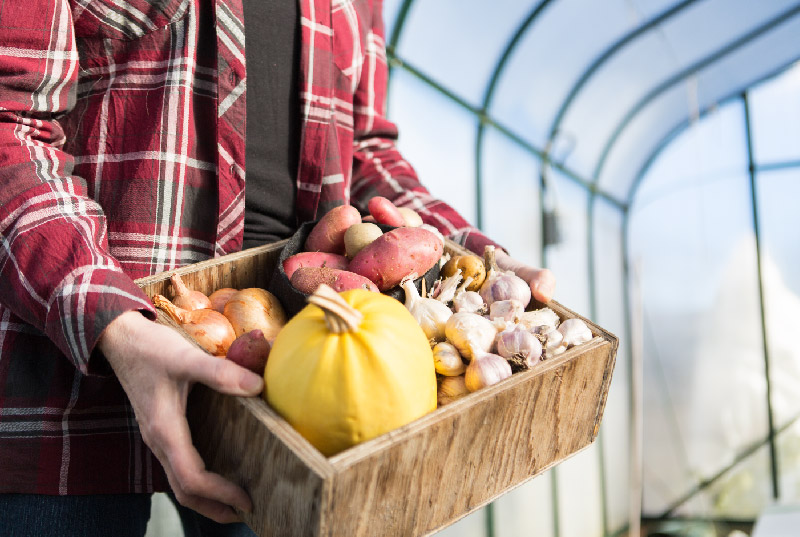
I help gardeners grow
& beginners blossom.
No seed left behind,
no soil unturned.
Together we can have lots of fun growing
great gardens using simple practical tips.
- Featured in -





Start saving & storing your garden seeds for a more more sustainable future
SIGN UP to get the FREE Seed packet PDF
X CLOSE

Growing Coffee From Seed
It’s an accident – I promise. The guide offers me a few coffee berries as he picks them and I pop them into the pocket of my shorts.
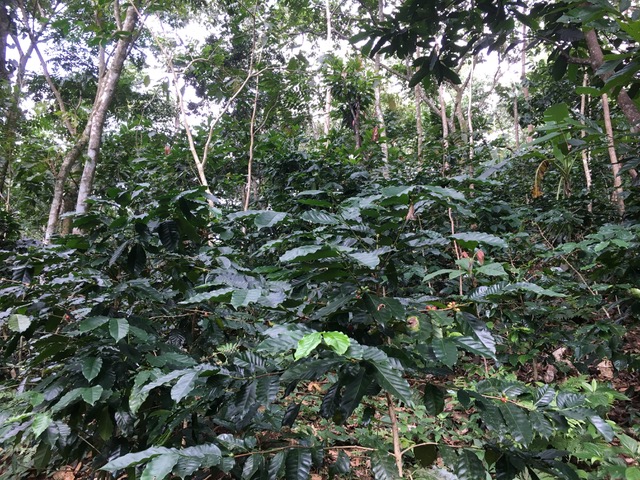
Organic coffee is grown in the shade in mixed tropical forests. When I visited a Mexican organic coffee grower in late November this is the coffee growing forest I discovered. It is a permaculture-style way to grow and not the row system of growing we are so used to in North America. If these steep forests were clean and single crop most of the soil would be lost to erosion on the steep slopes.
I am navigating a small creek and waterfall in my less than perfect hiking gear (read flip flops) and I am focussed on getting back to the trail and off the slippery path.
Later, back home in Canada, I am doing laundry when I clean my pockets and discover the now-dried coffee beans. Bringing them home was an accident but maybe I should right this wrong and grow these seeds? I can grow my own coffee in the house, wait for it to bloom and then roast and brew a few beans for friends. In the jungle the organically-grown plants prefer shade so maybe they’ll work in a window in my home? I am newly home from Mexico and enthusiastically excited about raising a crop of coffee in my windowsill.
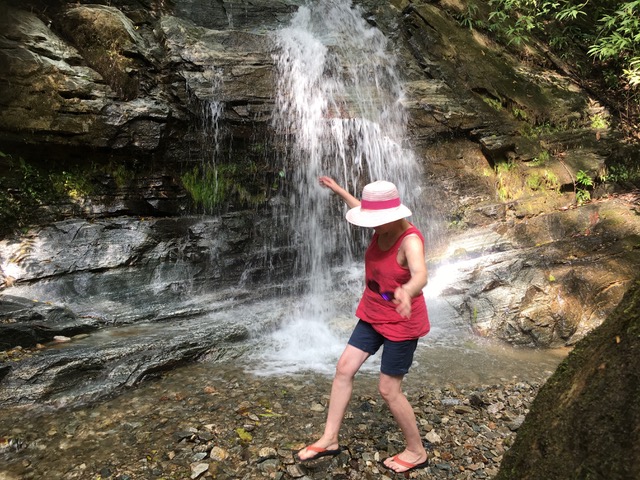
The shady forest where organic coffee is grown includes an upper canopy of chocolate (Cocoa) trees as well as Bananas and numerous other unknown tropical trees. It is not like any farm I have ever seen. Instead it is like a permaculture project. A mixed forest with a varied cover and assorted trees.
The shiny red fruit has dried around the beans when I find them in the laundry room so the first thing I do is take them to the kitchen to soak them and remove the dry red shell from around the seed. I have been told at the farm that freshly skinned beans are covered in a jelly. Once this sweet jelly is removed, the seeds are planted into sand, where they germinate quickly. I soak the seed right away so I can “clean” it and plant it tonight.
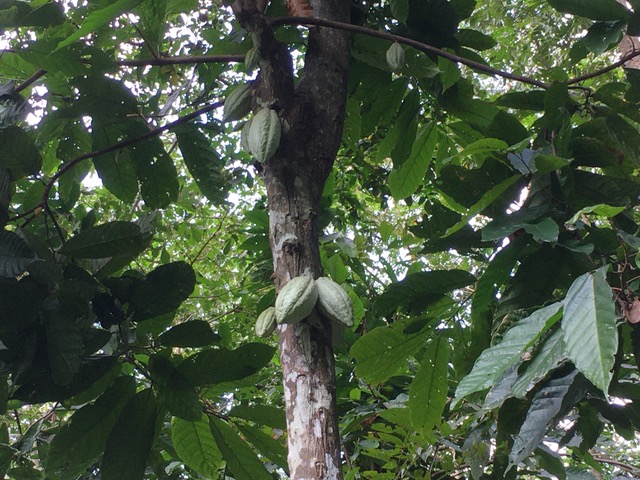
Cocoa pods hang directly off the upper canopy trees in the organic coffee plantation. The unique pods are 8-12 inches long. At the front, right of this photo the glossy-leaved coffee plant grows under the shade of the forest canopy.
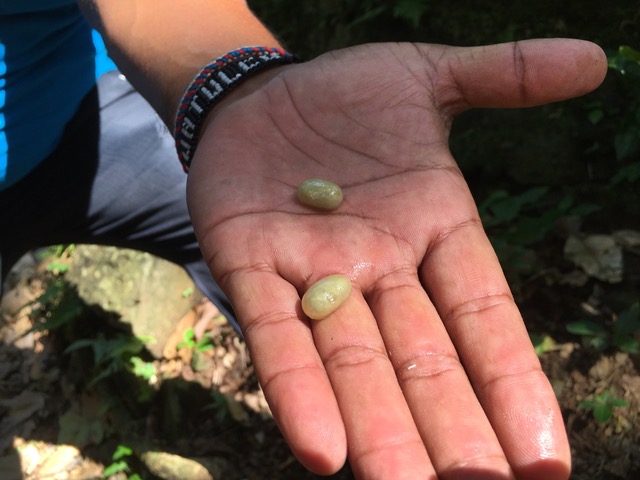
Once the red seed cover, or flesh, is removed there is a sweet gooey layer on top of the seed. This is removed before the seed is clean and ready to grow or dry for roasting.

Crews tie a rope around their waist as they scale steep mountain slopes of Pluma Hidalgo in the state of Oaxaca, Mexico to pick the ripe coffee fruit into baskets. These baskets are dumped into bags and brought to the main washing, sorting and drying area to prepare the coffee for roasting and selling into the online market or to tourists. In Mexico, coffee plants were introduced 100 years ago from Africa where they are native. The organic farm we visited in Mexico is run by third and fourth generation farmers and the fifth generation is barely old enough for school. The youngest is serving us Canadian beer wrapped in a napkin as we return from our mountain exploratory trip.
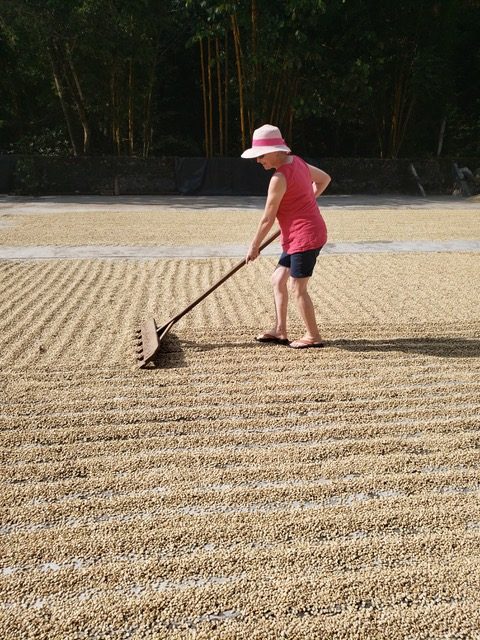
Once grown, picked, skinned and washed, the beans are spread out to dry on a paved area. I am raking the seed to turn it over. Once turned a few times, the seed gradually dries. Coffee is ready to roast when the moisture level in the seed is at 12%.

Clean dry coffee beans are roasted in a special oven that heats them continuously and stirs the beans as they roast. This constant turning while roasting prevents the beans from burning.
Sorting the beans by size before roasting lets the roaster more accurately cook the beans evenly instead of burning the small beans and undercooking the larger ones. We are told only the best and biggest beans are packaged for the tourists. “The less than perfect smaller beans are roasted, ground and sold abroad to Tim Hortens and Starbucks” jokes our guide.
I think of all the stages it takes to grow great coffee as I brew the roasted beans I buy and bring home. I wonder if I will get my “accidental” seeds to germinate and grow to produce my own beans. And then I wonder how I will roast them evenly in my oven to make sure they are neither burnt or undercooked. I notice it takes half a cup of ground beans to make an eight-cup French Press of coffee. I will need quite a big harvest to make a cup of coffee. At times like this I realize how we depend, in Canada, on the generations of farmers and their contract help picking the seasonal harvest. They are growing and picking and processing beans and getting them into our hands for our breakfast cuppa. They are managing hundreds of acres of land to get us a daily cup of organic fair trade coffee.
I grow most of my own food but I doubt, even with my talents for growing, that I will ever be self sufficient with home-grown coffee. But seeing the whole operation, walking the trails and participating in the drying and roasting tells me one thing: Coffee is a complex and tropical treasure and I am grateful to the generations of farmers who manage and tend the shade-grown crop I adore. Rich and sweet to the taste. Delicious and hot on this cool and frosty December morning in Canada.
SURPRISE! Seeds just sprouted on February 4, 2020 after being seeded Dec 4, 2019. Cross my fingers! I might be well on my way to growing my own coffee.
Donna Balzer is the Brand Ambassador for BCGreenhouse Builders and she has two greenhouses in her big backyard.

What Would Donna Do?
Get my growing and gardening tips and pointers throughout the season.
















Hilarious – I went to a tea farm too and I thought it was too much work…. tea leaves need to be processed once picked and there is a ratio between blossoms and leaves. Same goes with olives. They have to be processed to eat. I realize I am not the home economist I thought I was. I love growing but processing is almost too much for me. I love to eat fresh as much as possible. Which reminds me – I need to order seeds to grow micro-greens this winter. Tis the season to be green and greens only take a week to grow on my light shelf.
I am a tea drinker and have often thought similar thoughts about growing my own Camellia sinensis to harvest leaves from. Even if you only get a cup or two would still be lots of fun.